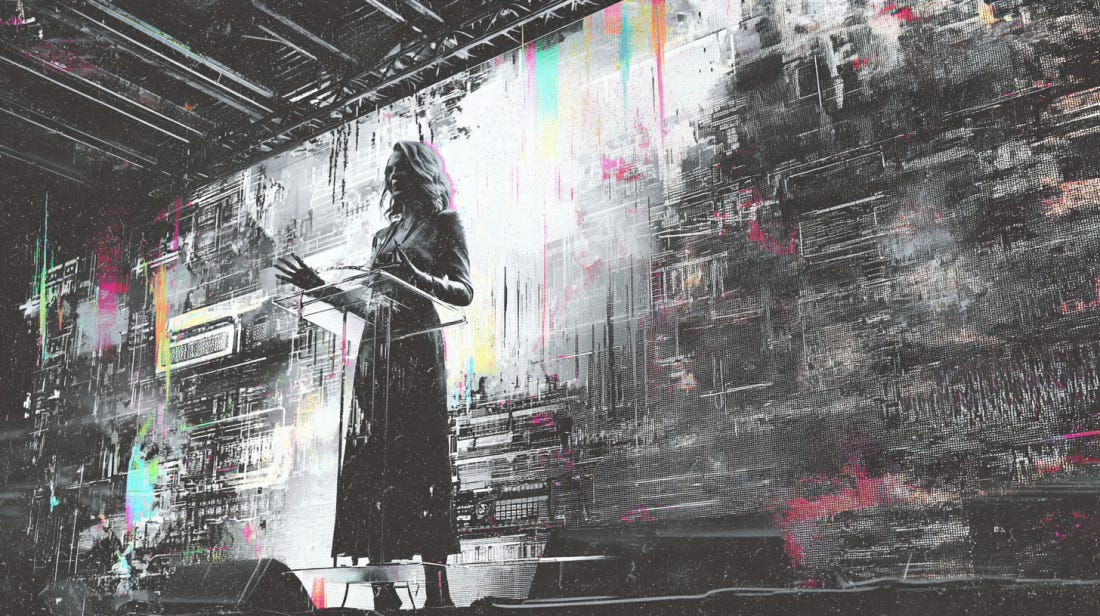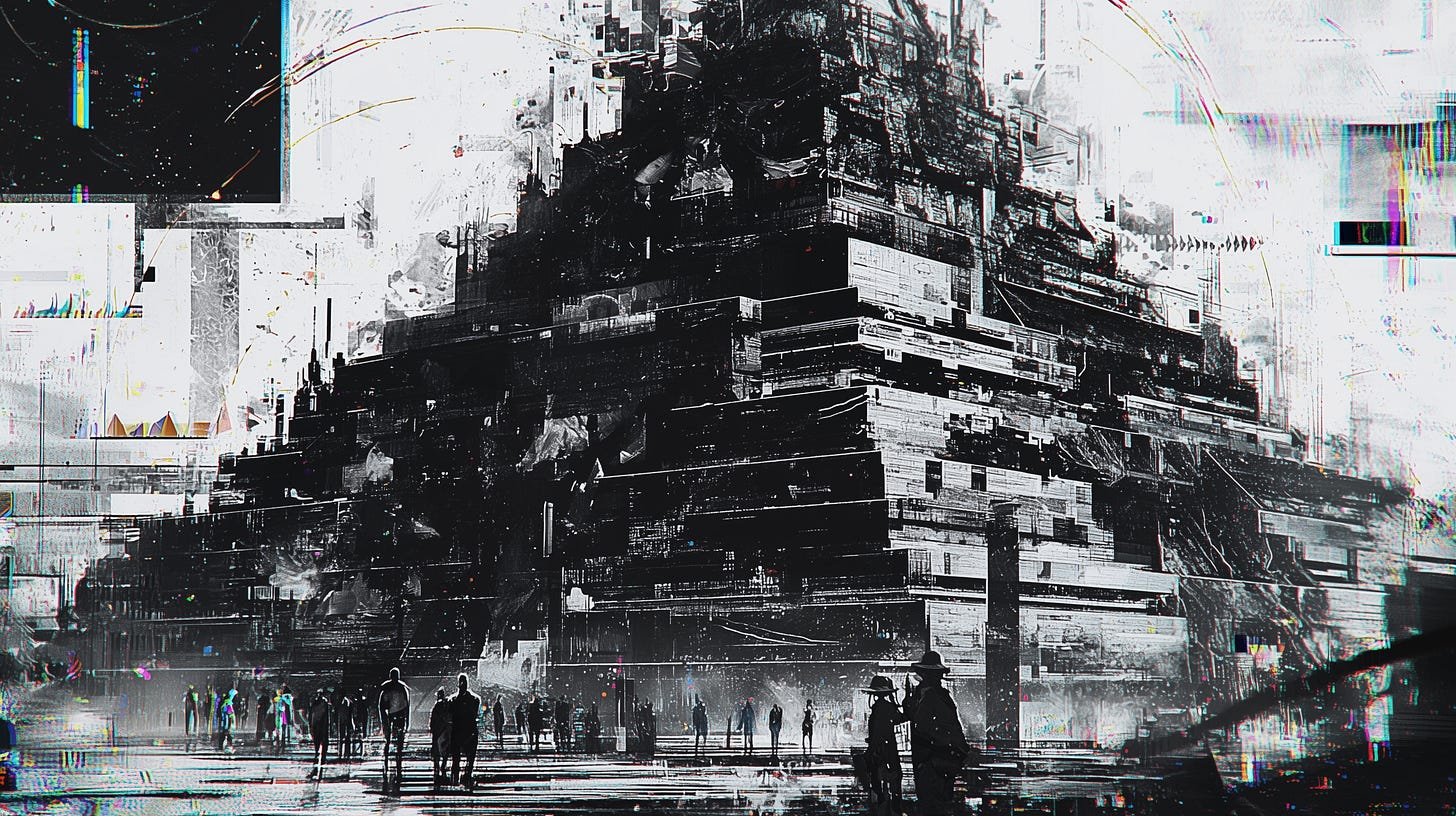Systems, Signals, and Scaffolding: UX in the Age of AI
A response from the DDX NYC Conference.
Crisis at the Mic
Her hand shot up:
“I am a UX copywriter. Do I have a career anymore?”
You could feel the tension ripple through the room.
The conference (DDX NYC) was a few weeks ago now. I wanted to see what stuck naturally, letting the signal come through the static.
Conferences can be whirlwinds of trends, gripes, and half-baked ideas. Sometimes, you need to let the tides of time wash the important flotsam ashore. Or maybe I was just procrastinating, and it was now or never. Both can be true, right?
I had launched Signal & Static the day we arrived in NYC, dragging ourselves through early summer heat, hopping between Tech Week events, excited to attend with a freshly tuned awareness.
She was young, maybe a few years in, eager to map her future in a field brimming with AI hype. The question came after a talk on structuring creative teams. It wasn’t directly on-topic, but it was most corporeal moment of the day.
“Can you tell me how your team uses AI for UX copy?”
The speaker fumbled before admitting:
“We use ChatGPT, for all of it.”
That was it.
It’s becoming common. Microcopy can feel small, unimportant. Something to scratch in later. But those “placeholders” often ship, meaning even the first draft matters. In a perfect world, I’d collaborate with a human copywriter on every word in a flow. But copywriters are often pulled to bigger projects, so yes: I use LLMs for draft copy. It’s better than lorem ipsum when you need to move fast without losing intention.
This moment sticks with me. It's easy to wave off as “just another AI anxiety moment,” but it raises real questions about authorship, accountability, and the value of craft.
Tools have always shaped what we make—not just the output but the way we think about making. That’s the cyborg way. The tool is part of the author. The way the chisel leaves marks in the marble. The way a telegram shapes the message. Systems are always shaping us, too.
What would I have told her? Learn the tools. Use every LLM you can. Know their strengths and flaws. You’ll be more prepared to shape your career—and lead with clarity in the work ahead.
To leaders: think critically about how you use AI. Don’t build a technophobic fortress, but don’t become a hype shop either. The gap between leadership and junior creatives is widening. It’s time to build a bridge.
// signal: co-creation tension detectedDesigning for the System, Not Just the Screen
“Experience is not an object. It’s an output.”
—Richard Dalton, Verizon
Let’s be real. I’m about as far from a Verizon fanboy as you can get (do those exist?), but Richard Dalton, Head of Consumer Design, hit on a core truth: [UX] Design isn’t just about screens; it’s about shaping the systems that produce experiences.
You don’t “create experiences.” People have them. Our job is to build and maintain the scaffolding that supports users within the system.
Dalton’s Ziggurat of Impact illustrated this with layered and dramatic clarity:
Experience lives under an architecure of taxonomy, measurement, portfolio, process, people, and is supported by money at the top.1
Experience is an emergent property of layered systems. You can’t design it in isolation.
Matt Wallaert (former Head of Behavioral Science at eminent design studio, frog) added:
If your design isn’t changing behavior, it isn’t doing anything.
Design is applied behavioral science. Without a behavioral objective, your product’s impact is immeasurable. Sometimes, intentional friction is necessary to guide that behavior.
Together, Dalton and Wallaert give us a methodology:
Be a system steward. Be a behavioral strategist.
The system shapes the experience, and the experience should shape behavior in return.
// cyborg reality: system + behavior = experienceCyborg Lens:
Cyborgs aren’t shaped by interfaces alone, but by systems underneath. Designers aren’t isolated creators; they are system choreographers. Measurement is how the system senses itself; behavioral strategy is how it steers.
Principles Before Prompts
“Are your design principles sharp enough for AI to execute?”
—Christian Hanke, Edenspiekermann
AI was everywhere at DDX (and everywhere else). The best leaders moved beyond hype, focusing on readiness.
Baylie Brenner-Bruzgis (Twitch) described “synthetic user testing” with LLMs to free up time for deeper thinking and creativity. Her advice: be an AI watchdog.
Christian Hanke (of legendary design studio Edenspiekermann) framed it perfectly:
Before you write prompts, sharpen your principles.
Bland, default outputs are becoming baseline. Strong design principles differentiate your work and your team in an AI-accelerated landscape. Culture, Hankke emphasized, is your new design system. It determines how you navigate exponential change without losing your edge.
Leaders need to know when to slow down, when to move fast, and how to give teams room to do both.
TLDR: Your principles must be operational enough to be executed by machines.
bash > AI integration status: cultural audit requiredCyborg Lens:
If AI is your co-pilot, who’s piloting whom? Tools aren’t neutral; they reshape us. Leadership in design means building adaptive, ethical scaffolding to co-evolve with technology.
Rituals and Autonomy
“Predictability isn’t bureaucracy—it’s scaffolding for creativity.”
—Baylie Brenner-Bruzgis, Twitch
How do you build a strong design culture? By structuring systems that support, not stifle.
Baylie shared effective rituals:
Repeatable intake processes for scoping and alignment.
Shared blueprints and transparent tooling (yes, in Jira).
Rituals for sync and async work to reduce chaos.
Structure isn’t control. It’s cognitive relief, creating space for designers to think, explore, and create.
Community as Ritual
During a roundtable, Dorsa Giyah (Product Designer, RBC Capital Markets) shared how she started informal coffee meetups with designers in Toronto—and brought the practice to NYC. It wasn’t about networking; it was about a repeatable, low-pressure ritual for designers to gather, share, and support one another.
In my studio, we have a monthly lunch hosted by one of our culinarily-gifted product designers. There’s one rule: if you enjoy the meal, you don’t talk shop. Period.
Dorsa encouraged others to build similar rituals in ways that fit their communities. It was a reminder that community is part of design practice, too. Show up consistently, make space, and design conditions for connection.
// community signal: activeOther Signals, Briefly
This piece could easily have been twice as long—there was a lot worth noticing at DDX.
Ryan Leffel (Head of Design, Priceline) reminded us of the power of A/B testing in innovation, bringing to life stories like the Egg McMuffin’s origin and referencing Big (yes, the Tom Hanks movie) as the ultimate user test in a corporate boardroom.
Ruchi Sharma (Meta) spoke to fostering innovation processes inside large teams.
Dan LaCivita shared the PACE framework from emergency response, helping teams assess impact and probability while emphasizing the importance of keeping “team cups full” to support creativity.
These signals deserve deeper exploration, but I’ve kept this dispatch focused. These are the insights that rose to the top.
What Sticks, and Why
It took weeks for the static to settle after DDX. Conferences can overflow with signals. Clarity comes with time.
Here’s what rose to the top:
Design for systems, not just surfaces.
Lead with principles before prompts.
Build rituals that enable creativity, not chaos.
AI is here—prepare to co-evolve.
That sounds a lot like being a cyborg, doesn’t it?
Reflection
Does this resonate?
What systems are you shaping, what rituals do you hold, and what fears are you facing as you design in exponential times? How are you preparing to co-evolve with your tools?
Hit reply or share your reflections. Let’s explore these signals together.
// end transmissionYou Might Also Like These Transmissions
🔗 Hello World
A welcome transmission, part logbook, part invitation. Where Signal & Static began.
🔗 The Cyborgs Aren’t Coming
We’re already entangled with our tools. A reflection on living inside systems, whether we notice or not.
🔗 Obsessive Interfaces
From mechanical keyboards to titanium pens: why some tools become extensions of self.
Support the signal: If you’re finding value here, sharing Signal & Static with a friend or colleague helps this space grow intentionally.





I love this: “The tool is part of the author. The way the chisel leaves marks in the marble.”
I would love to hear some of the cocktail chatter at DDX, and your thoughts regarding whether AI will decimate or create opportunities for UX, digital PMs, designers, strategists, etc.
I research and write about how AI will impact our daily lives. On any given day I fluctuate between thinking AI will create tons of new opportunities or kill most of our jobs.